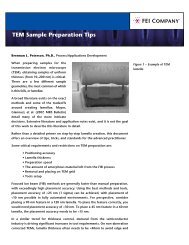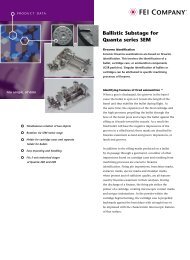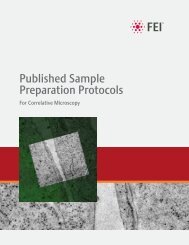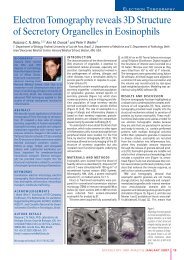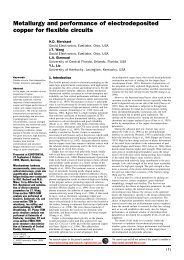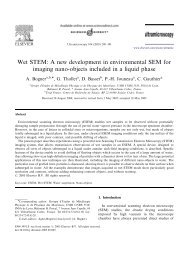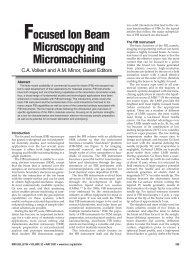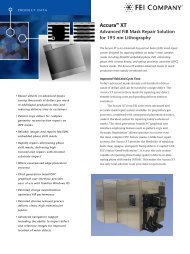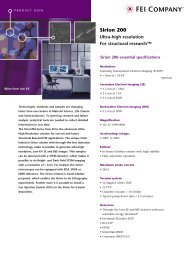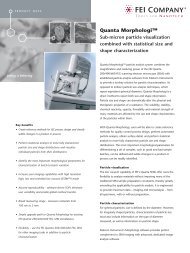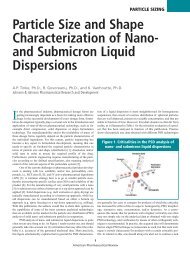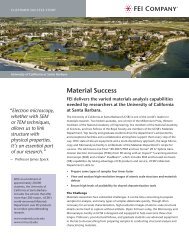Focused ion beam technology, capabilities and ... - FEI Company
Focused ion beam technology, capabilities and ... - FEI Company
Focused ion beam technology, capabilities and ... - FEI Company
Create successful ePaper yourself
Turn your PDF publications into a flip-book with our unique Google optimized e-Paper software.
6<br />
Useful signals<br />
As many signals are generated simultaneously, they<br />
may be used for detect<strong>ion</strong>, if efficient detect<strong>ion</strong> is possible.<br />
In this way all charged particles can be used as an<br />
imaging signal source, but the many neutral atoms are<br />
not used. Instead, these neutrals are the main component<br />
in the sputtering process <strong>and</strong> they are removed by<br />
the pumping system. Depending on the condit<strong>ion</strong>s,<br />
some of the neutrals may redeposit close to the area of<br />
milling. The charged particles, both <strong>ion</strong>s <strong>and</strong> electrons,<br />
can be used as an imaging signal. Since the <strong>ion</strong> <strong>beam</strong><br />
can be highly focused <strong>and</strong> scanned over the area it can<br />
be applied to create images at high magnificat<strong>ion</strong>. Note<br />
that the milling process itself continues during imaging<br />
but at a very low rate, because small spots <strong>and</strong> low<br />
<strong>beam</strong> currents are used for this. Although the top layer<br />
is removed continuously with every scan during imaging,<br />
in practice it is negligible in many cases. Another<br />
advantage of this gradual low rate milling is that the<br />
sample is “continuously cleaned” during imaging.<br />
The particles emitted from the surface during the irradiat<strong>ion</strong><br />
with the <strong>ion</strong> <strong>beam</strong> are schematically shown in<br />
Figure 5.<br />
Figure 4: The Ga liquid metal <strong>ion</strong> source, including<br />
the reservoir.<br />
If the sample materials matrix has different alignments,<br />
as in a multi-crystal phase, <strong>ion</strong>s may have a much<br />
higher or lower channeling yield depending on the<br />
local crystallographic orientat<strong>ion</strong>. As the <strong>ion</strong> is much<br />
larger than the electron, the sensitivity for the “projected<br />
atom compactness” is far higher. This phenomena,<br />
known as <strong>ion</strong> channeling, can be used to study the<br />
local differences in crystal orientat<strong>ion</strong>. It is also possible<br />
to use the (secondary) <strong>ion</strong> signal itself to create an<br />
image <strong>and</strong> in for example crystallography materials<br />
such as metals it will produce an excellent addit<strong>ion</strong>al<br />
contrast that shows the different grains of the material.<br />
The contrast of the <strong>ion</strong> signal can be different from the<br />
SE contrast (channeling, voltage contrast) <strong>and</strong> therefore<br />
<strong>ion</strong> imaging can give addit<strong>ion</strong>al informat<strong>ion</strong>.<br />
Although the majority of atoms emitted from the<br />
sample are not used, the emitted <strong>ion</strong>s can be used. In<br />
principle it is possible to analyze <strong>ion</strong>s <strong>and</strong> determine<br />
species <strong>and</strong> quantities by secondary <strong>ion</strong> mass spectroscopy<br />
(SIMS). In this way elemental distribut<strong>ion</strong>s are<br />
revealed during the milling of a sample, so in the third<br />
dimens<strong>ion</strong> as well.<br />
Substrate atoms<br />
milled from sample<br />
Collis<strong>ion</strong> with<br />
substrate atoms<br />
Ga + implantat<strong>ion</strong><br />
Incident Ga + Beam<br />
Figure 5: Interact<strong>ion</strong>s of the <strong>ion</strong> <strong>beam</strong> with the sample surface. The<br />
unique control offered by <strong>beam</strong> currents <strong>and</strong> spot sizes allow use<br />
of the FIB for both nano engineering as well as for high resolut<strong>ion</strong><br />
imaging using secondary electrons as well as <strong>ion</strong>s.<br />
<strong>ion</strong><br />
10 nm<br />
Secondary electron<br />
<strong>ion</strong>izat<strong>ion</strong>



